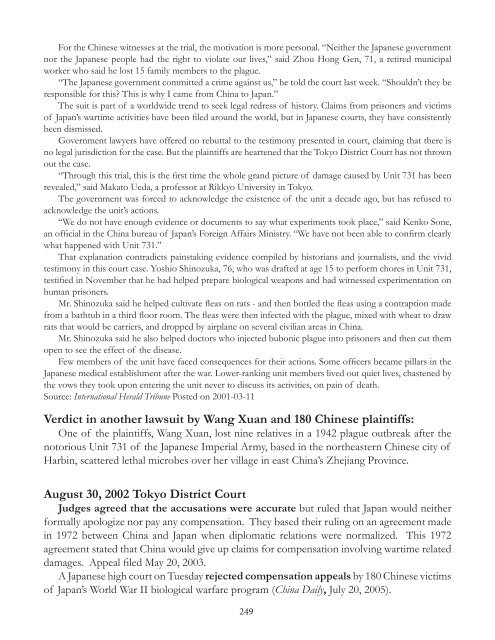Download - Canada ALPHA
Download - Canada ALPHA
Download - Canada ALPHA
Create successful ePaper yourself
Turn your PDF publications into a flip-book with our unique Google optimized e-Paper software.
For the Chinese witnesses at the trial, the motivation is more personal. “Neither the Japanese government<br />
nor the Japanese people had the right to violate our lives,” said Zhou Hong Gen, 71, a retired municipal<br />
worker who said he lost 15 family members to the plague.<br />
“The Japanese government committed a crime against us,” he told the court last week. “Shouldn’t they be<br />
responsible for this? This is why I came from China to Japan.”<br />
The suit is part of a worldwide trend to seek legal redress of history. Claims from prisoners and victims<br />
of Japan’s wartime activities have been fi led around the world, but in Japanese courts, they have consistently<br />
been dismissed.<br />
Government lawyers have offered no rebuttal to the testimony presented in court, claiming that there is<br />
no legal jurisdiction for the case. But the plaintiffs are heartened that the Tokyo District Court has not thrown<br />
out the case.<br />
“Through this trial, this is the fi rst time the whole grand picture of damage caused by Unit 731 has been<br />
revealed,” said Makato Ueda, a professor at Rikkyo University in Tokyo.<br />
The government was forced to acknowledge the existence of the unit a decade ago, but has refused to<br />
acknowledge the unit’s actions.<br />
“We do not have enough evidence or documents to say what experiments took place,” said Kenko Sone,<br />
an offi cial in the China bureau of Japan’s Foreign Affairs Ministry. “We have not been able to confi rm clearly<br />
what happened with Unit 731.”<br />
That explanation contradicts painstaking evidence compiled by historians and journalists, and the vivid<br />
testimony in this court case. Yoshio Shinozuka, 76, who was drafted at age 15 to perform chores in Unit 731,<br />
testifi ed in November that he had helped prepare biological weapons and had witnessed experimentation on<br />
human prisoners.<br />
Mr. Shinozuka said he helped cultivate fl eas on rats - and then bottled the fl eas using a contraption made<br />
from a bathtub in a third fl oor room. The fl eas were then infected with the plague, mixed with wheat to draw<br />
rats that would be carriers, and dropped by airplane on several civilian areas in China.<br />
Mr. Shinozuka said he also helped doctors who injected bubonic plague into prisoners and then cut them<br />
open to see the effect of the disease.<br />
Few members of the unit have faced consequences for their actions. Some offi cers became pillars in the<br />
Japanese medical establishment after the war. Lower-ranking unit members lived out quiet lives, chastened by<br />
the vows they took upon entering the unit never to discuss its activities, on pain of death.<br />
Source: International Herald Tribune Posted on 2001-03-11<br />
Verdict in another lawsuit by Wang Xuan and 180 Chinese plaintiffs:<br />
One of the plaintiffs, Wang Xuan, lost nine relatives in a 1942 plague outbreak after the<br />
notorious Unit 731 of the Japanese Imperial Army, based in the northeastern Chinese city of<br />
Harbin, scattered lethal microbes over her village in east China’s Zhejiang Province.<br />
August 30, 2002 Tokyo District Court<br />
Judges agreed that the accusations were accurate but ruled that Japan would neither<br />
formally apologize nor pay any compensation. They based their ruling on an agreement made<br />
in 1972 between China and Japan when diplomatic relations were normalized. This 1972<br />
agreement stated that China would give up claims for compensation involving wartime related<br />
damages. Appeal fi led May 20, 2003.<br />
A Japanese high court on Tuesday rejected compensation appeals by 180 Chinese victims<br />
of Japan’s World War II biological warfare program (China Daily, July 20, 2005).<br />
249


